A common practice for growing onions is to plant in early spring and harvest in late summer. More recently, gardeners have come up with a method of growing winter onions. Winter varieties of onion sets do not require additional hassle to grow, give a plentiful harvest and are not drowned out by weeds. Agronomists bred special varieties and hybrids that can survive winter frosts, grow stronger and grow in winter under short daylight conditions and give quick shoots in early spring.
Content
Why plant onions in the fall
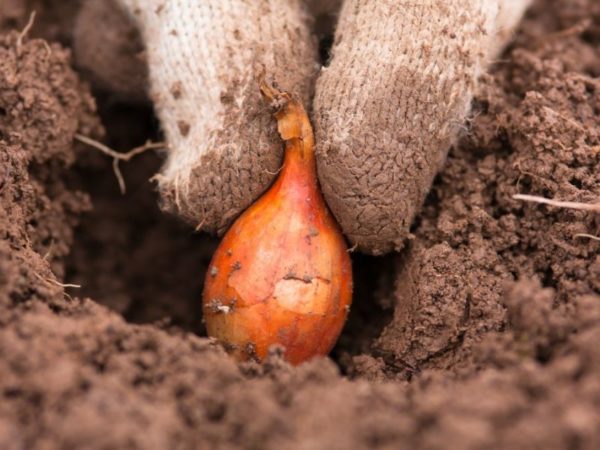
Winter landing - a new word in the agricultural technology of growing onions. Using a planting in the fall, the gardener achieves the following goals:
- transferring part of the garden work to autumn, the gardener saves valuable spring time;
- winter onions awaken from hibernation immediately after the arable land is freed from snow. Regarding the traditional method, this gives him a head start in growing in 3-5 weeks;
- by moving the onion growing season to early spring, the gardener already in July frees arable land for the next crop;
- Autumn planting protects the onion from being damaged by insect pests;
- overwintered bulbs are practically not affected by gray rot and powdery mildew;
- early ascending plantings do not need watering;
- winter planting provides the gardener with a very early harvest of greenery;
- onion ridges with overwintered plantings are not affected by weeds;
- onions grow very large;
- planted sevoc is well preserved in the ground. The gardener gets rid of worries about storing sevka in the winter.
Advantages and disadvantages of the method
Winter planting vegetables have their advantages and disadvantages.
Advantages of the method:
- onions planted in autumn give stable yields in early summer. Early vegetables can be sold profitably;
- Harvested at the beginning of summer, the land frees. This makes it possible to grow two crops from one ridge;
- early sprouted onions suppress the development of weeds around;
- early spring plants are less affected by harmful insects;
- onions grown in early summer are perfectly stored;
- the small sowing planted in autumn giving all the energy for growing the bulb practically does not shoot;
- large bulbs planted in winter planted before winter delight with an extra early harvest of feather.
However, this agricultural technique has its drawbacks:
- during the long winter, part of the plants may die. Therefore, the amount of planting material is increased by 1/10;
- autumn plantings must be sheltered from early frosts. This increases the cost of growing and requires a large consumption of covering materials.
Selection of onion varieties for winter cultivation
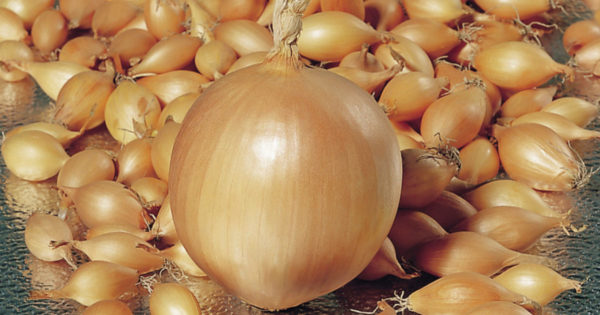
Two parameters are important for plants used for autumn-spring cultivation: frost resistance and good growth with a short daylight hours. A vegetable planted in autumn in order to survive the cold winter must take root and adapt in a short autumn time. Later varieties of onions reveal their qualities only with a long daylight, so it makes no sense to use their onions for planting.It is also useless to plant onions of southern varieties, revealing their qualities only during high summer temperatures.
A large number of onion varieties for winter onion planting were bred by Russian and Dutch agronomists.
Arzamas
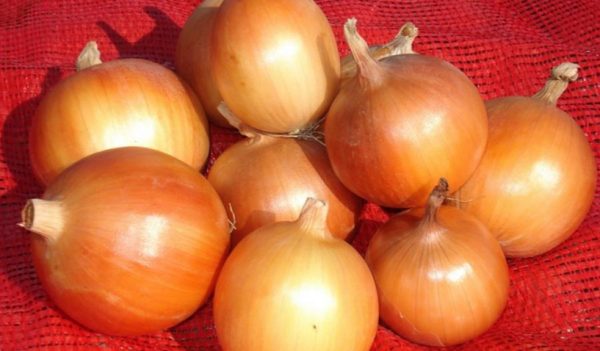
The variety was bred by folk breeders in the last century. It is adapted for cultivation in central Russia and the Urals. The bulb is round, its mass reaches 80 grams. The color of the husk is dark yellow with a brown tint. The taste of the onion is very sharp. The variety is mid-ripening, from germination of seeds to lodging of tops - 70-90 days. Harvest can be up to three kilograms per square meter. The disadvantage of the Arzamas variety is its poor resistance to downy mildew.
Danilovsky
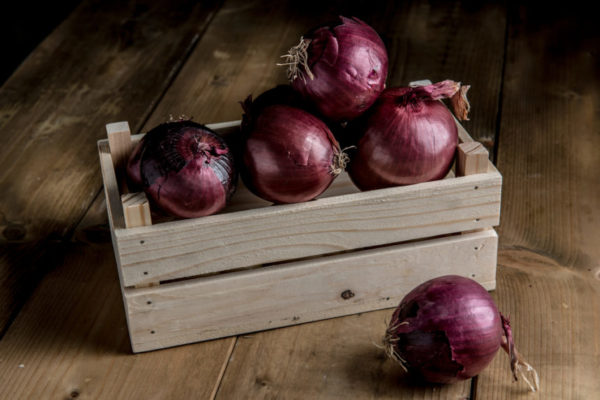
The variety was bred by agronomists of the Yaroslavl region. It grows well throughout almost all of Russia. The bulb is rounded flat, its mass can reach up to 160 grams. The color of the husk is red-violet. The taste of the onion is soft, slightly sweet. Danilovsky variety of onions is used in the preservation and preparation of dishes and salads. The variety is mid-season. When growing from seeds, the crop is harvested 110-120 days after planting, while growing by sowing, after 90-100. The crop reaches three kilograms per square meter.
Radar
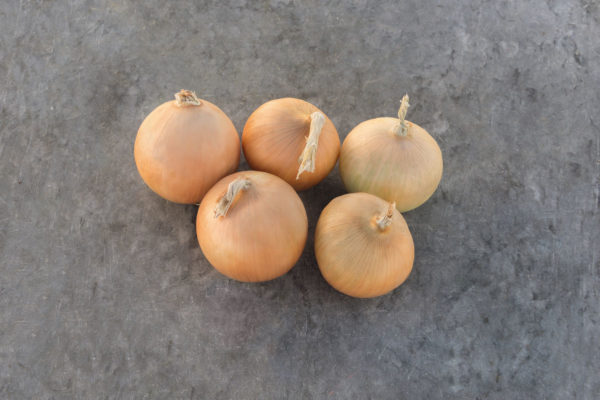
Hybrid - a product of the work of Dutch agronomists. The variety is zoned throughout the Russian Federation. The bulb grows up to three hundred grams in weight, rounded in shape, golden yellow. Designed for the use of winter sowing agricultural technology, tolerates frosts up to minus 23 degrees. The variety is resistant to shooting, practically does not get sick and is not affected by pests. The variety is early ripe, with winter planting sowing, the crop is received in early June.
Red baron
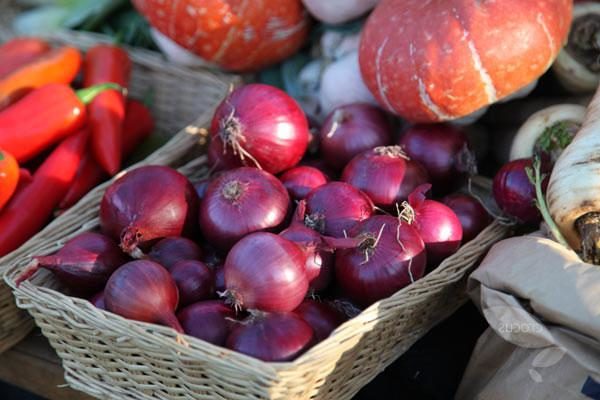
Variety Red Baron bred by Dutch agronomists. The variety grows well throughout almost all of Russia. Bulb of flat oval shape. With good care, its weight can reach up to 200 grams. The color of the pulp and scales of the vegetable is burgundy. Due to the unusual color of the pulp, Red Baron is often used to decorate dishes on the festive table. The taste of the vegetable is slightly sharp. A distinctive feature of the Red Baron variety is the absence of characteristic onion bitterness in the taste. The variety belongs to early ripening, the crop is harvested already three months after planting. Its productivity reaches up to four kilograms per square meter. A distinctive feature of the Red Baron variety is the absence of characteristic onion bitterness in the taste.
Senshui
The result of the work of Japanese breeders onion Senshui grows well almost throughout Russia. The variety is specially bred for winter planting. The bulb grows up to 250 grams in weight, flat in shape, straw yellow. The variety has a sharp taste. The variety belongs to early ripening, the crop is harvested in early summer. Senshui is very frost-resistant. Bulbs withstand frosts up to 15 degrees. With proper care, the yield of the variety reaches 4 kilograms per square meter.
Strigunovsky
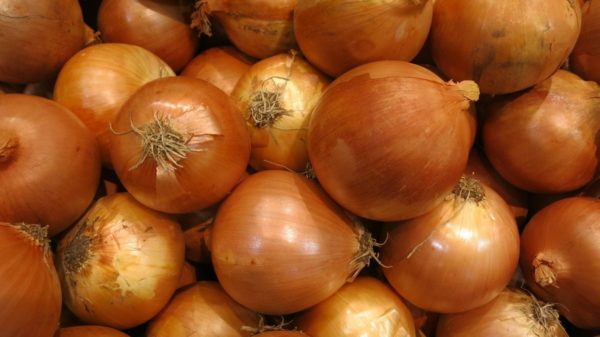
An old variety of onions Strigunovsky bred by Russian agronomists. The variety is intended for cultivation in central Russia. The bulbs are round, their weight reaches 120 grams. The color of the scales is yellow. Strigunovsky variety of onions has a sharp taste. The variety refers to early ripening, with winter planting, the crop is received in early summer. The yield of the variety reaches three kilograms per square meter.
Sturon
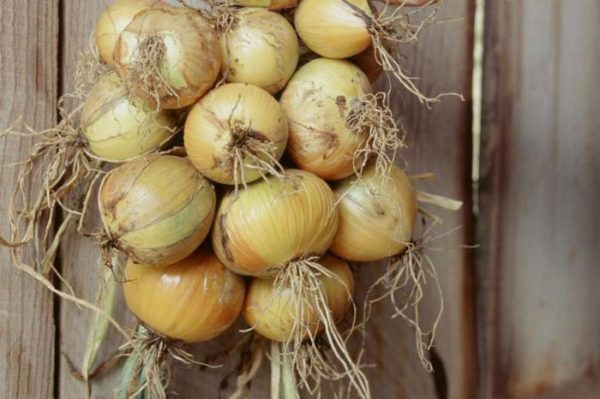
The result of the work of Dutch agronomists is the bow of Sturon. Variety bred from a common variety Stuttgart Riesen. Sturon is intended for cultivation almost throughout the territory of Russia. The variety is frost-resistant, bulbs planted in the soil do not freeze in the winter. Bulbs are rounded, slightly elongated, their weight reaches 220 grams. The color of the scales is yellow-brown.Onion Sturon has an exceptionally sharp bitter taste. The variety refers to early ripening, with winter planting, the crop is received in early summer. Productivity reaches three and a half kilograms per square meter.
Centurion
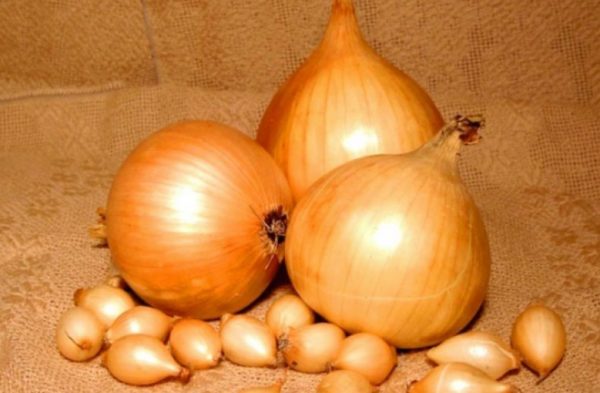
The result of the work of Dutch agronomists is the bow Centurion F1. The variety is intended for cultivation almost throughout the territory of Russia. The bulbs have an elongated shape, their weight reaches 120 grams. The color of the scales is yellow. The taste of onions is delicate, medium-sharp, the vegetable is perfect for salads and preparations. The variety refers to early ripening, with winter planting, the crop is received in early summer. The yield of the variety reaches four kilograms per square meter. Centurion rarely releases arrows and is practically not sick.
Shakespeare
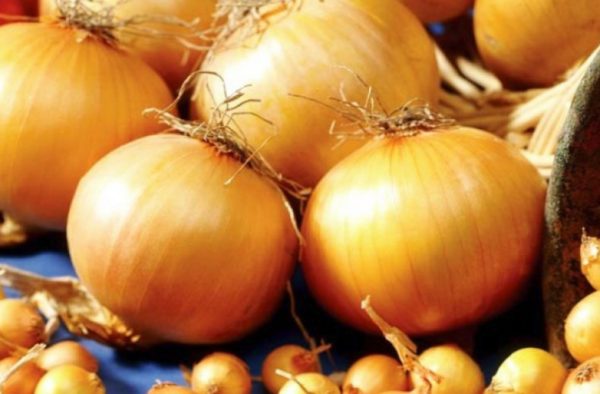
The result of the work of Dutch agronomists is Shakespeare's bow. The variety was bred for winter sowing, intended for cultivation in the central and northern regions of the Russian Federation. The bulbs are round, slightly flattened, their weight reaches 100 grams. The color of the scales is yellow-brown. The taste of onions is medium sharp. The variety refers to early ripening, with winter planting, the crop is received in early summer. The yield of the variety reaches three kilograms per square meter. Shakespeare is extremely resistant to disease and very rarely shoots arrows.
Stuttgart Riesen
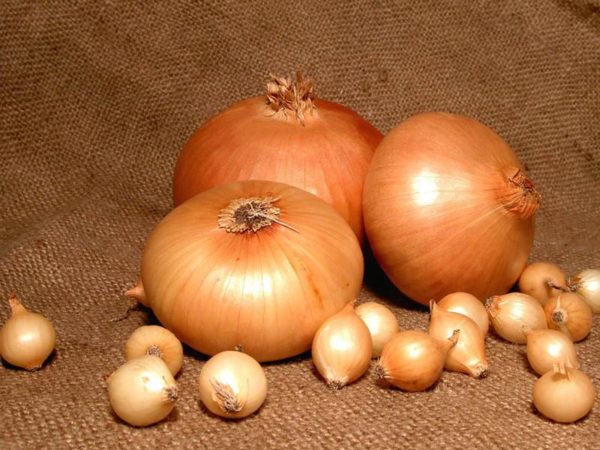
Stuttgart Riesen bred by German breeders. The variety grows beautifully throughout almost all of Russia. The bulbs are round, slightly flattened, their weight reaches two hundred and fifty grams. The color of the scales is yellow. The taste of onion is semi-sharp. The variety is mid-season; the yield of the Stuttgart Riesen variety, with proper care, reaches eight kilograms per square meter. Stuttgart Riesen is resistant to diseases and parasites.
Ellan
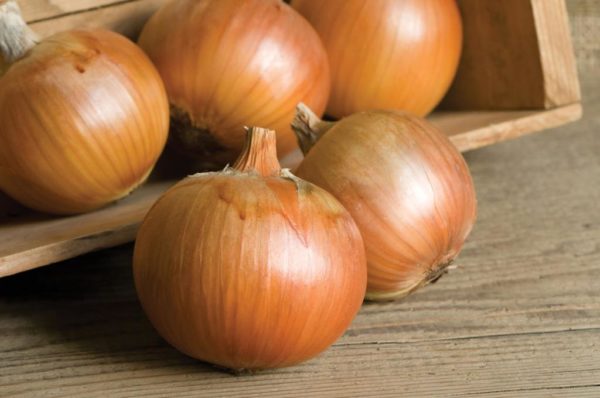
The onion variety Ellan is relatively recently bred by Kuban breeders. The variety is adapted for cultivation throughout the Russian Federation. The bulbs are round, the bulk of the crop has a weight of 100 grams, but with good care, individual specimens reach a weight of half a kilogram. Onions have a sweet flavor, so it is well used in salads, in the preparation of a variety of dishes and preparations. The variety refers to early ripening, with winter planting, the crop is received in early summer. Due to the sweet taste and the absence of bitterness, people with gastrointestinal diseases can eat Ellan onions.
The technology of growing winter onions
After selecting and acquiring seed material, you can begin planting work. Winter onion planting is carried out just 10-15 days before the beginning of stable night frosts. A planted bulb should have time to firmly catch its roots on the ground, but the appearance of a long feather will inevitably lead to the death of plantings. More precisely, the landing time can be found by the weather forecast. If weather forecasters promise a stable week + 5-7 degrees during the day, with a gradual decrease in temperature, then it is time to plant onions in the ridges.
On this basis, the optimal planting dates for Moscow Region are the beginning of October, November for the southern regions of the Russian Federation, and the end of September for the Urals and Siberia.
Arable land preparation
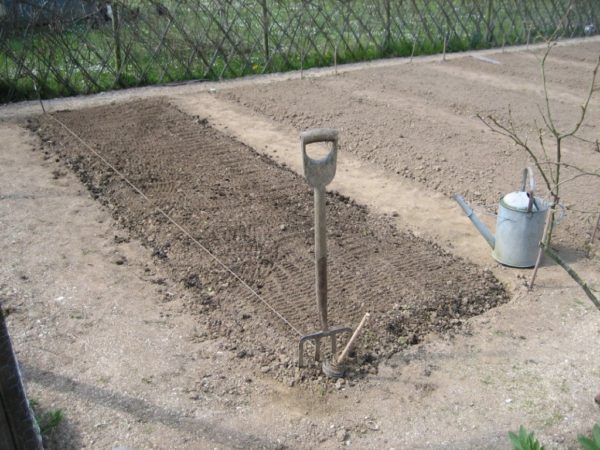
For winter onion cultivation choose a well-lit place on which snow quickly melts in the spring. It is also important that the future arable land does not stagnate because bulb crops die in a humid environment. A loose soil with neutral acidity is optimal for onions.
The vegetable will grow well on the ground, where rapeseed, beets, mustard, tomatoes, cabbage, or crops were grown before it. Low yields will be when growing onions after carrots, potatoes, legumes, cucumbers or any onion crops.
Before planting, the soil is dug with the simultaneous application of fertilizer. To increase productivity for digging, humus or compost is made in the amount of 1 bucket per square meter. Additional 1 sq.m. contribute 2 tbsp. superphosphate and wood ash and one spoon of urea. Before sowing onions, lime, furnace ash, ground chalk or superphosphates are added to acidic soils.
Preparing planting material
An important stage in obtaining a plentiful harvest is the proper preparation of planting material. Bulbs intended for planting inspect and discard rotten, dried, damaged ones. After that, they are divided by diameter:
- up to 1 centimeter (oatmeal) is planted to obtain turnip onions;
- from 1 to 2 centimeters (sevoc) - to obtain heads and fresh spring greens;
- more than 2 centimeters onions are planted solely to obtain a large amount of early greens.
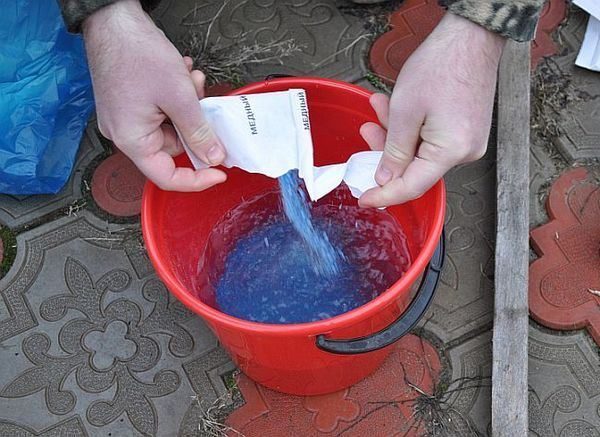
For protection against onions for 10 minutes soaked in solution copper sulfate or potassium permanganate, and then dried for 12-24 hours.
Winter onion planting
Planting onions carried out according to the following algorithm:
- Choosing a place on the plot for onions, fertilizing, digging arable land, the device and design of the beds.
- Preparation of planting material, rejection of low-quality seeds, separation of planting material by diameter.
- Marking the beds for planting. Furrows make a landing marker, departing from the edge of the ridge 10 cm. The distance between them is 15-25 cm.
- Bulbs are planted in the grooves. To obtain an onion feather, the distance between vegetables is 5 cm, to obtain marketable onions, depending on the variety, 10-12 cm. Planting material is buried in the ground by 5-8 cm.
- After planting, the bulbs are covered with earth and covered with freezing layer of mulch, sawdust, spruce branches or straw.
Planting onions with seeds
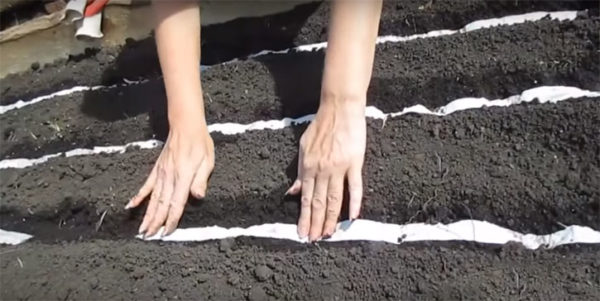
After preparing the soil, seeds are planted in the grooves, onions glued to the tape. The distance between the grooves is 30-35 cm, the depth of the seeds is 3-3.5 cm. After planting, the tapes are covered with earth. To obtain a good harvest, the topsoil is periodically watered and loosened. In winter, the ridges are covered with mulch, straw, sawdust or covering material.
How to care for landings
After the onset of warm days and the beginning of thawing of the earth, shelter from the ridges is removed. The land freed from shelter warms up faster, the plants in it awaken. Further care for winter onions in the spring consists of timely watering, top dressing and weeding of weeds.
Two weeks after the appearance of the first spring shoots, the first feeding of onions is carried out. The first feeding is aimed at the formation of the green part of the plant, so it is carried out with nitrogen fertilizers. For this, 30 grams of ammonium nitrate, 40 grams of superphosphate and 20 grams of potassium chloride are dissolved in ten liters of water.
The second top dressing is carried out three weeks after the first. This time they carry out complex feeding for the formation of the whole organism. To do this, in one bucket of water, 30 grams of ammonium nitrate, 60 grams of superphosphate and 30 grams of potassium chloride are bred.
The third top dressing is carried out to form the onion head. To do this, 40 grams of superphosphate and 20 grams of potassium chloride are bred in ten liters of water.
Harvesting and storage
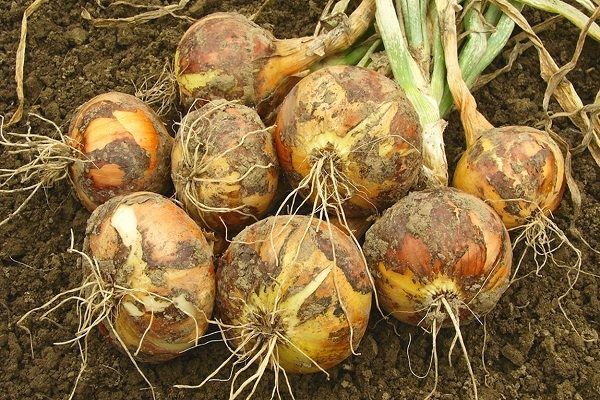
Harvest of winter onions begin to be harvested in early summer, when the feather of the onion dries and lays on the ground. By this time, all the nutrients from the feather and the roots pass into the head.Bulb growth stops, integumentary leaves dry out and acquire a color inherent to the variety.
Harvesting onions is carried out in dry, warm weather. For this, the bulbs are gently dug up with a small spatula and pulled out of the ground by the feather. After that, the vegetables are laid out in a blown place for drying.
A well-dried onion is cut before storage. Long roots and a dried feather are removed with scissors, leaving a neck 4-6 cm long. The cut onion is dried for another two weeks, after which it is removed to the main storage location.
Before laying for storage, vegetables are carefully sorted, removing damaged and rotten specimens. Healthy bulbs with dry necks are left in storage.
At home, onions are stored in vegetable baskets, wooden crates, fabric bags, nylon stockings or nets. All containers must have openings for ventilation. For better preservation of vegetables in boxes or bags, they are scattered with a layer of up to 30 cm.
Store onions in the basement on racks or in trays at temperatures from zero to minus 3 degrees with a humidity of 75-90%. During home storage, the optimum temperature is plus 18-22 degrees with a humidity of 50-70%.
During storage, each month, onions are sorted, removing rotten vegetables. If the onion is damp, it is carefully sorted, dried and cleaned in a dry container.
Pests and diseases of onions
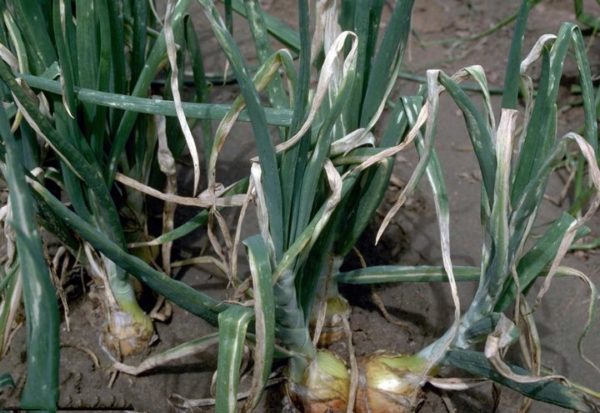
To get a rich harvest, you need to fight diseases and pests of onions. The main diseases affecting the vegetable:
- peronosporosis,
- rust,
- Fusarium rot
- cervical rot of the bottom,
- green moldy rot.
The harmful insects are also dangerous:
- onion root tick,
- onion moth,
- onion fly
- onion bug
- onion stem nematode.
To combat diseases, various industrial preparations or folk agricultural products are used. To protect plants from insects, pesticides are used.
To prevent crop losses from diseases and pests, preventive measures are used:
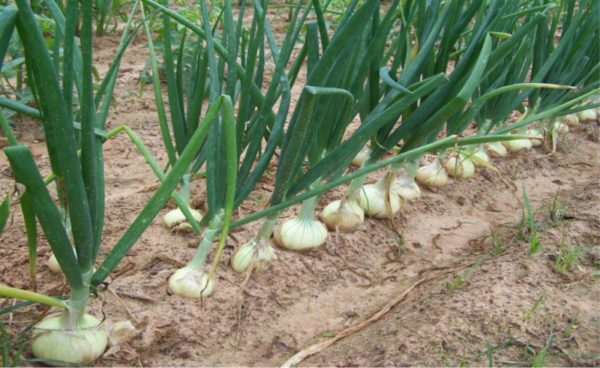
- planting only healthy planting material reduces the risk of outbreaks of disease;
- the best yields yield regionalized varieties that are most adapted to the climate of the area;
- crop rotation application. Vegetables should return to the place of planting after 3-4 years;
- the right choice of predecessor cultures;
- heat treatment of seeds before sowing eliminates many pathogenic microbes;
- high-quality planting of winter onions and care in the open ground, timely watering and top dressing, weed control increase the yield and reduce the risk of plant damage by diseases and pests;
- ripe onions in the garden are stored very poorly. Timely cleaning protects the bulbs from getting wet and rot;
- careful rejection of damaged and diseased bulbs ensures long-term storage of the crop.
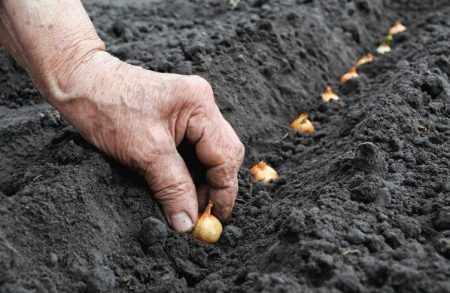 You may be interested in:
You may be interested in:Planting onions in the fall saves valuable spring time. Varieties and hybrids specially bred by agronomists tolerate winter frosts and quickly wake up in the spring. Winter onions are very rarely affected by diseases and pests, inhibit the development of weeds around them and yield crops in the first half of summer. The juicy feather grown from large onions is excellently realized and brings additional profit to the gardener, and a strong bulb growing from a blackberry is perfectly stored until the next harvest.

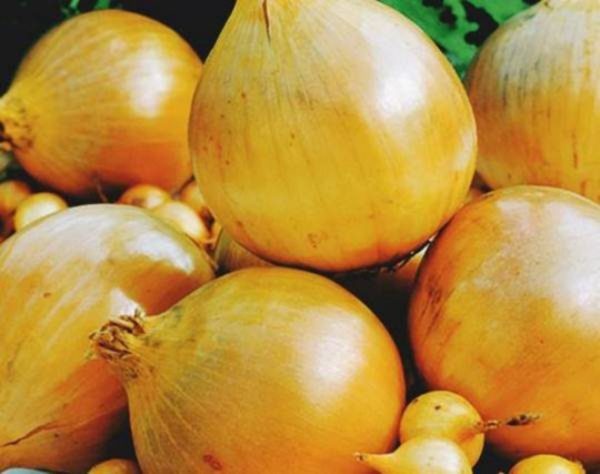
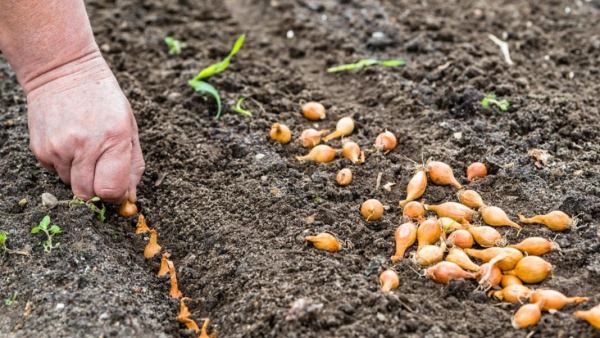
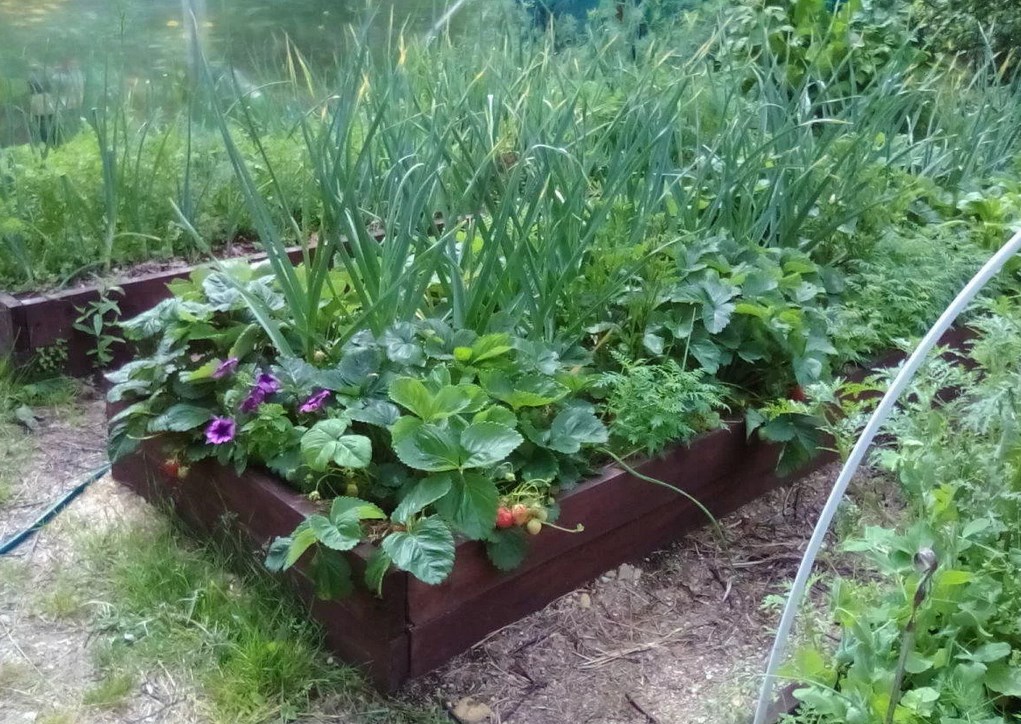
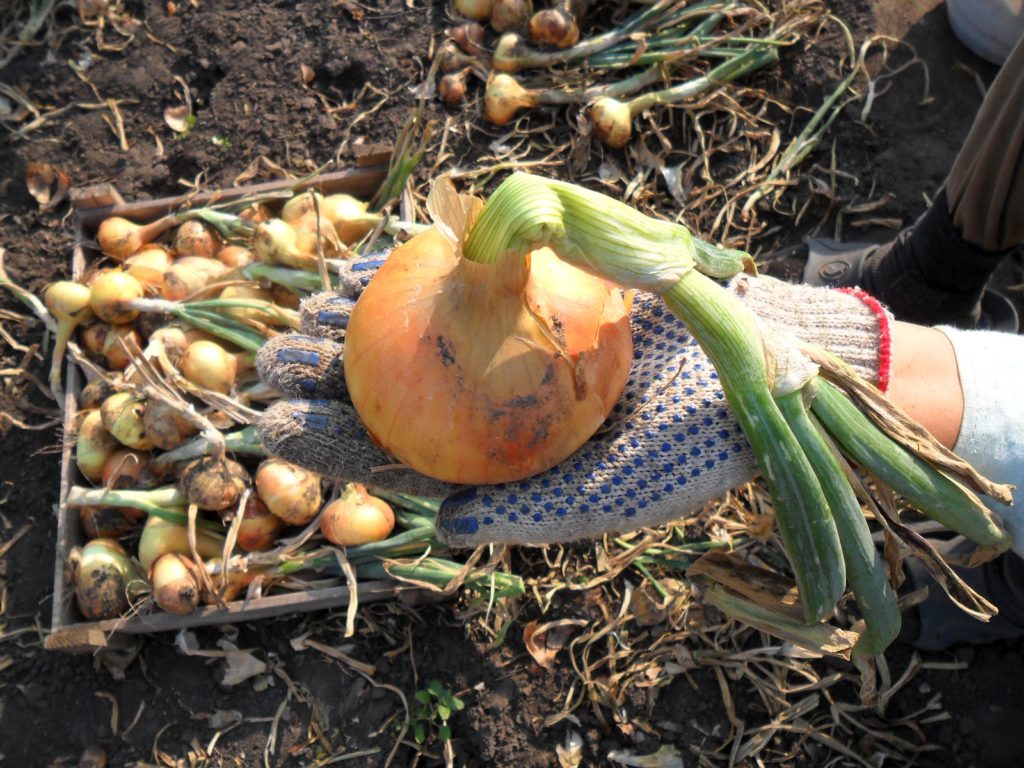
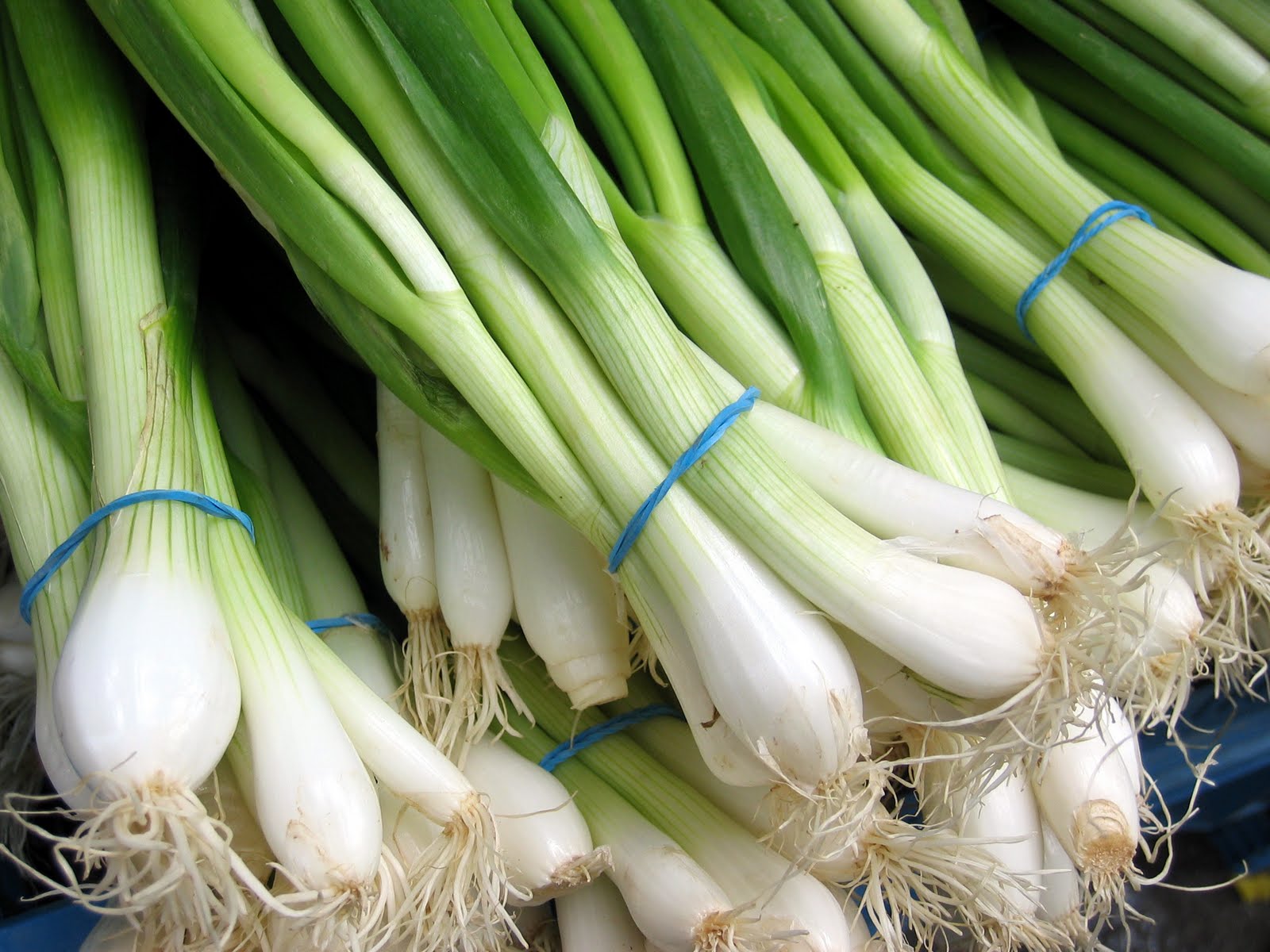 Growing onions on a feather in a greenhouse in winter
Growing onions on a feather in a greenhouse in winter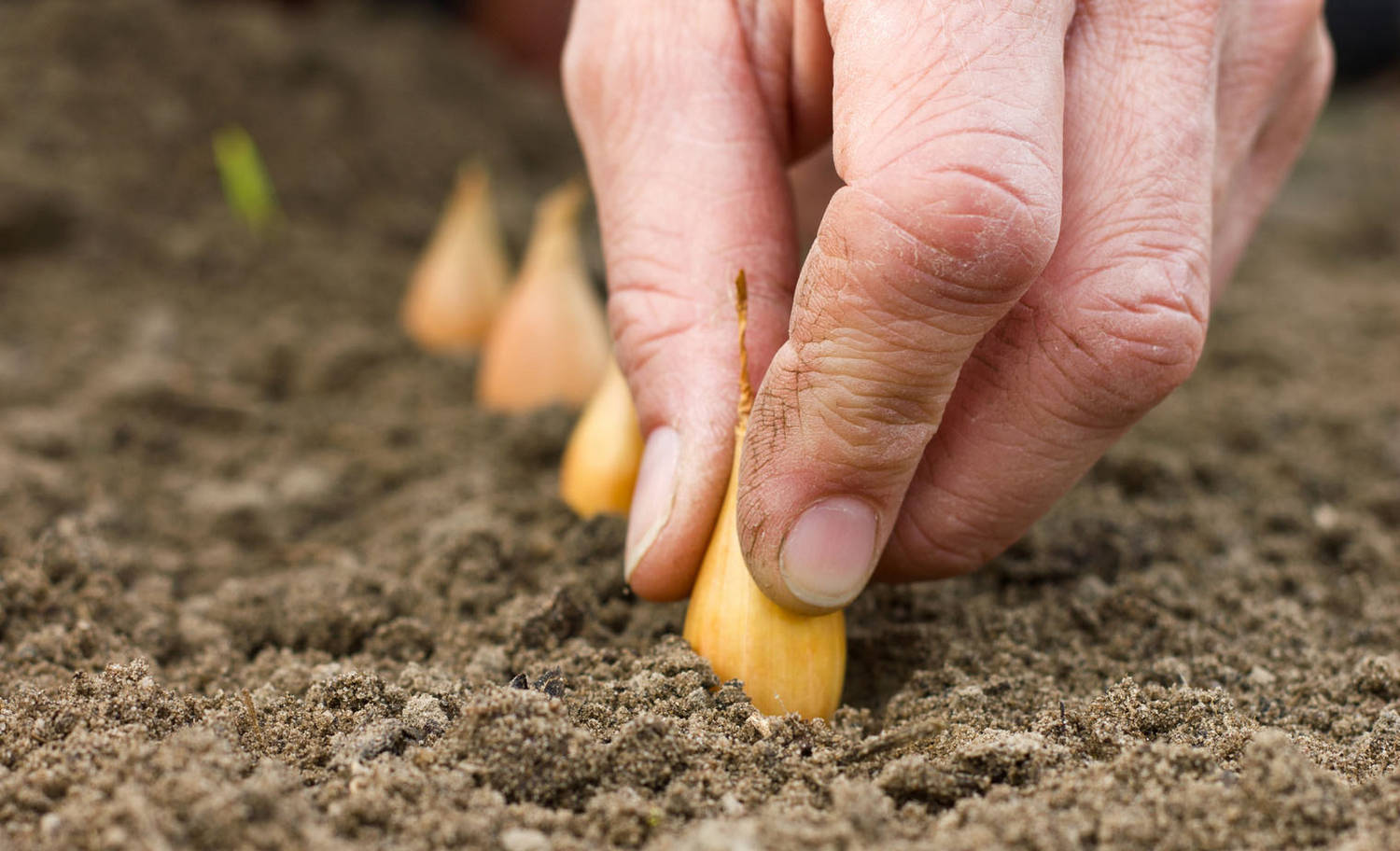 Planting onions in winter in the open ground
Planting onions in winter in the open ground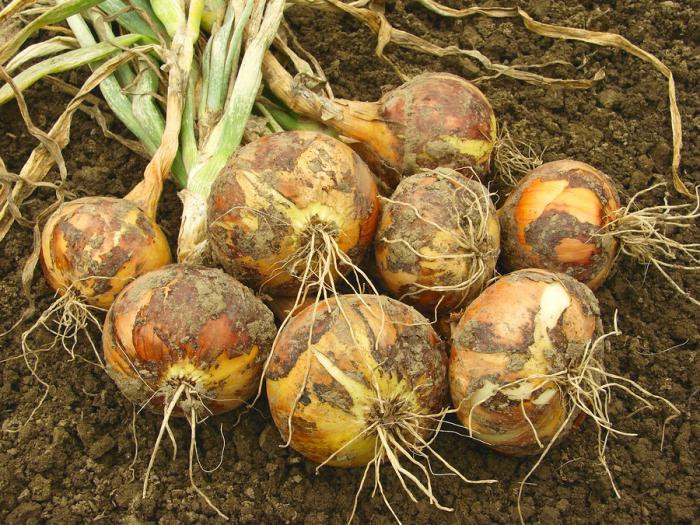 How to feed onions so that the bulbs beat large
How to feed onions so that the bulbs beat large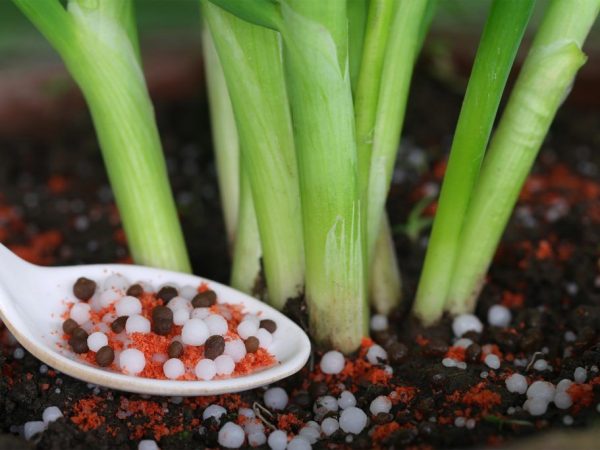 How to feed onions in spring and summer to get a good harvest?
How to feed onions in spring and summer to get a good harvest?